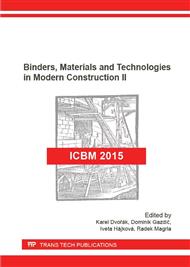p.22
p.27
p.32
p.37
p.42
p.47
p.53
p.57
p.62
Hydrothermal Synthesis of Tobermorite at 170 and 190 °C from Fly Ash and Quartz Sand
Abstract:
Tobermorite is the main mineral which provides to aerated concrete mechanical properties. It is produces during hydrothermal conditions by reacting silicon and calcium oxides. Within this research was evaluated tobermorite formation using high temperature combustion fly ash and quartz sand, as the siliceous raw materials. As a binder was used lime. Emphasis was also placed on the molar ratio of C/S, which is crucial for the formation of tobermorite and was given 0.73 and 1.00. Hydrothermal synthesis was carried out in a laboratory autoclave at temperatures of 170 and 190 °C.
Info:
Periodical:
Pages:
42-46
Citation:
Online since:
August 2016
Authors:
Price:
Сopyright:
© 2016 Trans Tech Publications Ltd. All Rights Reserved
Share:
Citation:


